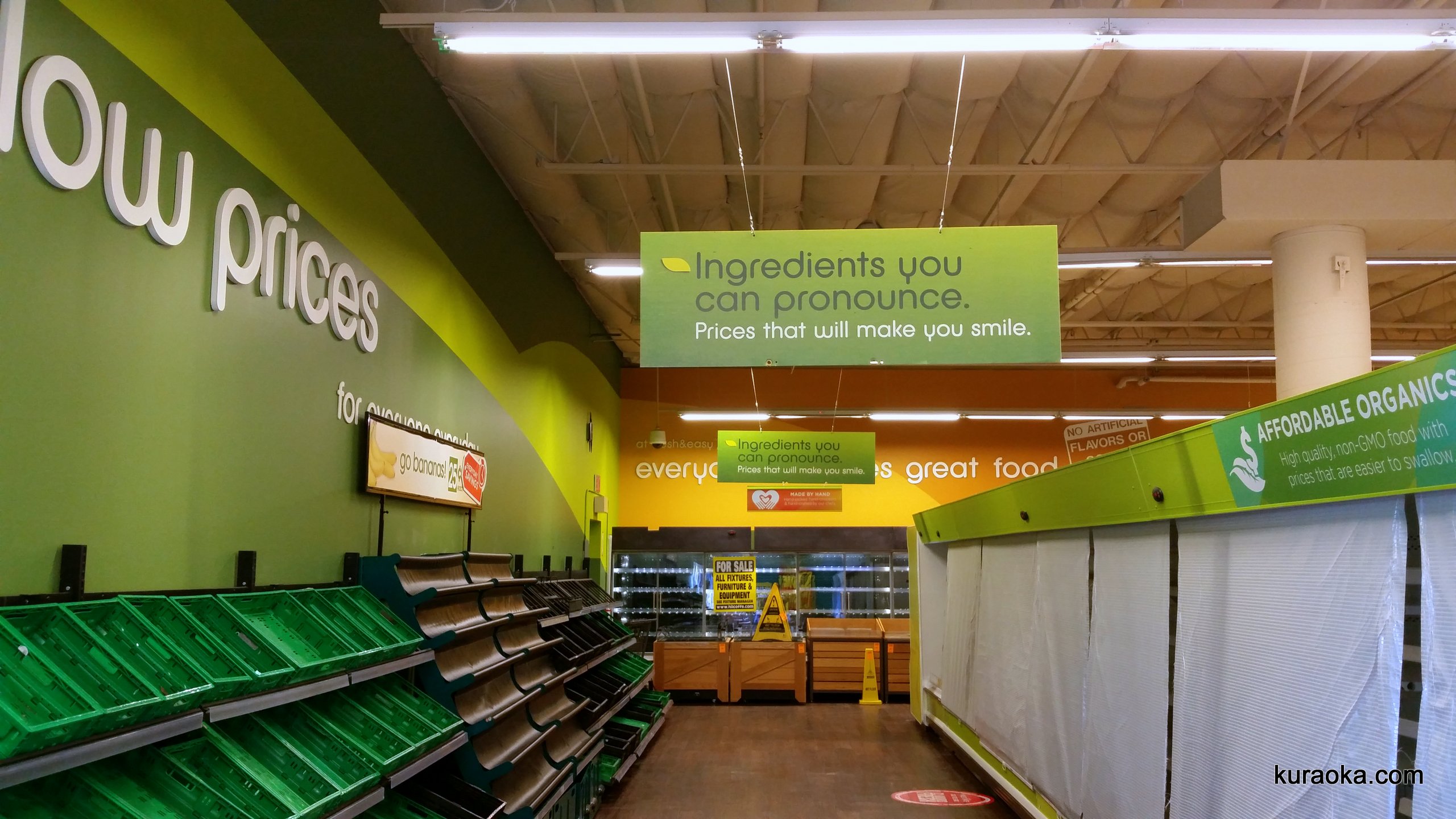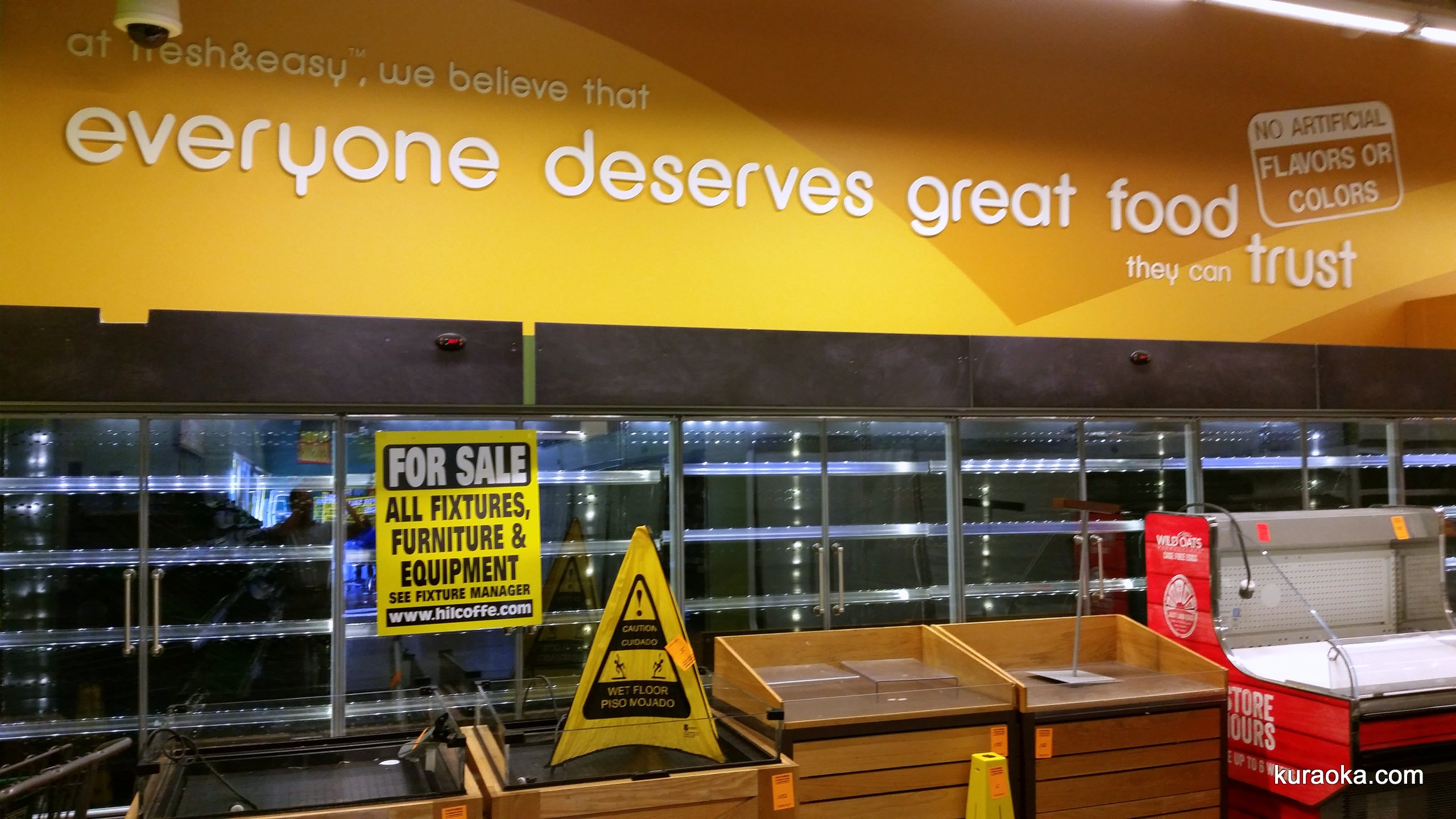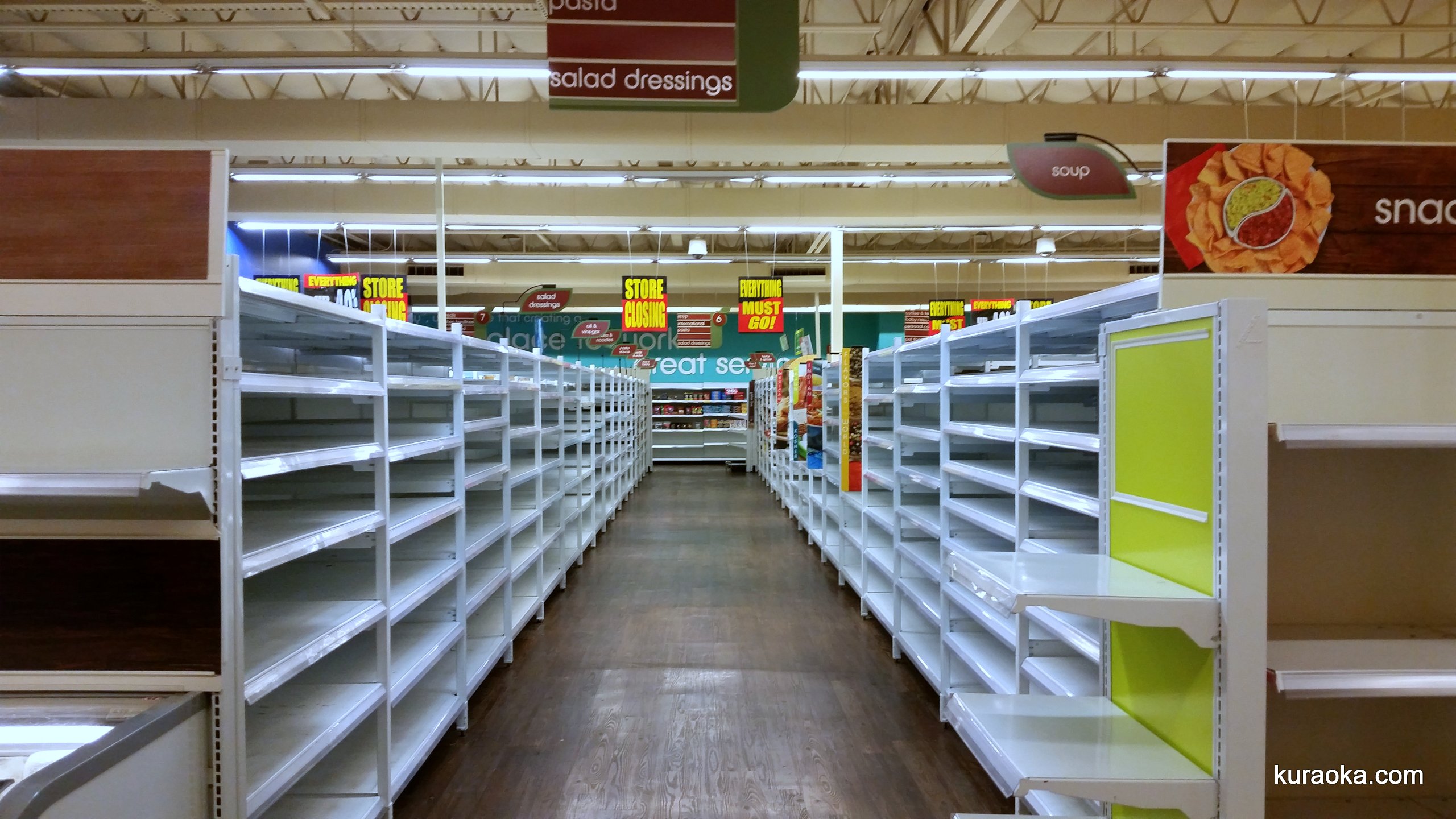It’s Friday the 13th – RIP Fresh & Easy. Here are a few photos taken over the last two days of the inside of my local store:





Quick finder (main website):
Home
| Advertising portfolio | Brochure portfolio | Services | Experience | FAQ | Advice
| About me | Contact
Quick finder (advertising blog only):
Ad Blog
main page | Monthly archives | Forward to January-June 2016 (Hey, I’ve been busy)
November 19 2015
I’m enrolled in a MOOC that’s studying various plays by Shakespeare. The play this week is Othello. Open Source
Shakespeare has a navigable version of the play’s text:
Advertising copywriter blog link
Here’s my four-sentence synopsis, for those unfamiliar with the tragedy. Othello, an older African military commander currently employed as a general for the dukedom of Venice, marries Desdemona, the young daughter of a Venetian senator. His trusted aide, Iago, stung by various real or imagined slights, sets out to destroy Othello. Iago carefully plants false seeds of doubt in Othello’s mind about Desdemona’s faithfulness. Once they take root, Iago nurtures them until they bear fruit: Othello, driven mad, murders Desdemona in their marital bed and, upon learning the truth, kills himself.
Iago is often said to be one of Shakespeare’s smartest, most unredeemably evil characters. He is Machiavellian in his cunning. And the whole story turns on his ability to persuade, to make Othello believe something that isn’t real.
He kicks off his campaign with a very old trick: he deprecates the very version of events he wants to sell. Far from dissuading Othello, it solidifies the apparent truth of the implications that follow. It’s as copywriting legend Bernice Fitz-Gibbon said a century ago about transparency in ad copy: “A little bad makes the good believable.” Even though there’s no “good” being sold by Iago, only falsehood, the basic sales technique works.
Despite its proven effectiveness, copywriters today seldom use this technique. Possibly because they don’t know it. But most-likely because most clients don’t want anything “negative” in their ads, even if – perhaps especially if – it’s the truth. Which is unfortunate.
Because truth sells.
Back to the top of the page
November 18 2015
The collection of offensive ads I mentioned Sunday is actually part of a newly released book. Here are a few more examples from Beyond Belief by Charles
Saatchi, from The Guardian (UK):
Advertising copywriter blog link
I think this is an important book. Not because it reveals an ugly aspect of American postwar growth, but because it’s a potent reminder that the views we hold today may be little more than culturally influenced prejudices. And just as likely to be derided 50 years from now.
That’s no reason to not market today’s innovations with all the energy we can muster – ad agencies owe that to their clients.
But, that’s equally no excuse for today’s versions of essentially similar marketing campaigns that seek to attract attention by belittling others.
Back to the top of the page
November 15 2015
A weekend quickie to point out this collection of sexist, racist, and otherwise offensive ads from what’s often called the golden age of advertising.
Here’s the story, from ad legend Charles Saatchi, via the Daily Mail (UK):
Advertising copywriter blog link
Some examples are more offensive than others. For example, racism and sexism are always abhorrent, and iṯs impossible to argue that that’s just the way things were because there were plenty of people around at the time fighting for what was right. But technological advances – like asbestos and nuclear power – will always be a mixed bag from the safety of hindsight. Pharmaceutical ads, health and wellness ads, even trade ads for industrial innovations, will almost inevitably seem ridiculous in retrospect.
One wonders how today’s ads for drugs, green energy, and other technologies will be viewed once more is known about their unanticipated side effects.
Back to the top of the page
November 13 2015
It’s Friday the 13th – RIP Fresh & Easy. Here are a few photos taken over the last two days of the inside of my local store:





The thought of all those layoffs is terrible, but seeing this brightly lit derelict really brings it home. Soon it will be dark, the remaining fixtures and stock to be sold by the lot, sight unseen.
Conceptually worded signage and a unique color palette did little to build the brand or move the merchandise, for the rudimentary reason that foot traffic never reached critical mass. And I maintain that the primary reason for the lack of foot traffic was the lack of advertising.
Heck, I was a regular customer, in this very store two or three times a week throughout its life, and I seldom saw more than one or two other shoppers in the place.
I believe that Fresh & Easy offered a better way to buy groceries. But it’s not enough to build a better mousetrap. You have to tell people about it,
long and loud.
Back to the top of the page
November 11 2015
The Shakespeare MOOC I'm taking is discussing Macbeth. Here’s the text of the play, from Open Source Shakespeare:
Advertising copywriter blog link
One major theme is equivocation: the use of language that can be interpreted two ways. And Macbeth employs double-speak from his very first line: “So foul and fair a day I have not seen.” And the apparitions handily fool Macbeth with their equivocations (“... for none of woman born shall harm Macbeth”).
We’ve all seen equivocation – what I call weasel words and phrases – in advertising. Sometimes, copywriters are actually directed to write it,
although one often can equivocate out of the need to equivocate if it really matters. (And there’s an example.) The problem with equivocation in ad copy is
that the intent isn’t to sell, it’s to deceive. And that puts it at odds with the purpose of advertising.
Back to the top of the page
November 8 2015
Just a Sunday quickie to point out this article, the latest post-mortem of grocery retailer Fresh & Easy. Here’s the story, from my hometown San Diego
Union-Tribune:
Advertising copywriter blog link
The article alleges a litany of things going wrong at the highest levels. But it all comes down to a lack of focus: lack of brand focus, lack of retail focus, and lack of tactical focus. All of which, from beginning to end, led to a failure to communicate to consumers any meaningful differentiator.
The corporate failure is a real pity because Fresh & Easy was a genuine market innovator. The company got a lot of things right. It offered in many ways a
better way to shop for groceries. It just never found its voice. And without a voice, it died as it lived: anonymously.
Back to the top of the page
November 6 2015
The play this week in the Shakespeare MOOC I’m taking is The Merchant of Venice. And here’s the text of the play, from Open Source Shakespeare:
Advertising copywriter blog link
Although most people know the play for its character Shylock the Jewish moneylender, that’s not actually what the play is about. For the record, I think the play is about extremism and hypocrisy, and I find all the main characters repulsive.
But the play is also about commerce, and that’s where it gets interesting from a marketing perspective. Antonio, arguably the titular merchant, isn’t a shopkeeper; he’s an import/export wholesaler operating on a global scale. He puts up money to buy or lease ships and crews, which sail to distant ports to buy or trade for cargo to be sold on. A contracted percentage of the proceeds is shared out among the crew upon their return. Another part repays expenses. What’s left is the merchant’s profit.
And this merchant makes a lot of money. Antonio says, “within these two months ... I do expect return of thrice three times the value of this bond.” The bond is for borrowing 3,000 Venetian ducats, or roughly $450,000 in today’s money. In other words, Antonio expects his ventures to return about $4 million in two months. He doesn’t say whether that’s net or gross, and one wouldn’t expect that he'd be trading at that level every two months. But it’s understood that he’s wealthy and successful.
How does he do it? Diversification. At the beginning of the play, Antonio tells his friends “I thank my fortune for it, my ventures are not in one bottom (ship) trusted, nor to one place; nor is my whole estate upon the fortune of this present year.” All of which turns out to be untrue, by the way; he’s fooling himself and three months later he’s bankrupt and indebted for the contracted pound of his flesh.
Companies, too, often believe they’re diversifying their marketing efforts because they run ads on multiple media channels. But that diversification is as
illusory as Antonio’s. In addition to constant advertising, you also need consistent PR, regular promotion, and ongoing social media content support (none of
which I do, by the way, so I’m not just angling for work here). Without sustained, continual outreach through diverse marketing channels, companies risk their
own pound of flesh. And it’s usually a competitor that collects it.
Back to the top of the page
November 5 2015
My neighborhood Fresh & Easy market is closing, as is the entire chain. Not that it’s much of a functioning grocery store any more. Here are photos showing
the last days of what, just eight years ago, was Tesco’s first major foothold in the U.S. market:


Even at knock-down close-out prices, the store, as you can see, is devoid of customers. And that was always the business problem, although as a customer I found it a positive because the aisles were clear and there was never a line and I could get in and out with several day’s of groceries in three or four minutes. Yes, I timed it.
So how is this final liquidation event being advertised? Ay, there’s the rub. It’s being advertised the same way Fresh & Easy advertised itself throughout its short, unprofitable life: almost entirely through its email list. Which is a fine, cost-efficient way to communicate, except that an email list only reaches people who are probably already customers. There’s little to no new-customer acquisition.
Then, when Fresh & Easy did try to generate new business, it did so through expensive direct mailers, made doubly expensive because it would always include coupons good for five or ten dollars off an entire purchase. That was the company’s answer to people who wanted to use manufacturer coupons, but not surprisingly it didn’t appeal to them and it trained existing customers to wait for the coupons. So foot traffic never caught fire and profitability per visit plunged, which meant income per square foot plummeted.
Never before have I seen a brand failure lie so squarely on predictible failures in marketing, nor one that would have been so easy to redirect toward success.
Of course, that’s easy to say with no knowledge of the budget or the politics within the corporation. It’s easy to envision success when one can also imagine an unlimited budget and supportive stakeholders. But, clearly, a broader mass message needed to get out, and the differentiators needed to be better articulated to resonate with real customers.
Considering neither was ever done, perhaps the real surprise about Fresh & Easy is that it lasted as long as it did.
Back to the top of the page
November 1 2015
I just wrapped up a MOOC on the battle of Agincourt. Here’s the Agincourt 600 website honoring the battle’s 600th anniversary one week ago today:
Advertising copywriter blog link
It was fascinating to learn the real history after the fictionalized portrayal in Shakespeare’s Henry V. But, being a class about a campaign of war, many events and situations were quite familiar to those of us in advertising.
Among them were things like Henry launching his campaign without having the money to see it through. To cover the second pay quarter, he has to put up his own jewels as security to make sure his troops get paid. Start-ups often underestimate the time and money it’ll take to penetrate a market. The blame usually falls on marketing and advertising as the most-visible part of the effort. But the root of the problem lies deeper, in securing enough money for a sustained campaign.
Henry also seems to expect little resistance upon his arrival in France, and the first big obstacle is a tougher nut to crack than his campaign can bear. He has to bail out and make a face-saving run for a friendly city, his original plan in tatters. Companies armed with data, innovation, vigor, and an alleged lack of competition may believe they’re launching into a vacuum. But they never are. Inertia competes with everything in every market, and it is very hard to move people to change their status quo.
Not that the competition fares better. Beset by civil strife and a weak king, France lets Henry establish a beachhead without a fight and defers a direct confrontation, enabling Henry to besiege and seize a strategic city. However, allowances must be made for the fact that big armies, such as one to invade or repel invasion, were essentially project-based groups. They were funded, recruited, mustered, and trained on a just-in-time basis.
Agincourt is the ad hoc French army’s first major engagement, and its commanders make rookie mistakes. They underestimate the opposition. They fail to reconnoiter the ground adequately. They fail to establish clear lines of command and control. They delay further, handing to Henry both the first-mover advantage and the defender advantage. They ignore the advice of more experienced leaders within their ranks. They may even fail to have a plan beyond a brace of cavalry charges (which fail) and a head-on run across acres of muddy fields. Those failures squander their army’s power and lead to a spectacularly one-sided defeat.
Sound familiar? Nokia. Saab. Lehman Brothers. Quiznos. Fisker. Blockbuster. Radio Shack. A&P/Pathmark and Haggen and Fresh & Easy. Amazon Local. It’s a list
that’ll keep growing because strategic and tactical mistakes are as timeless as great stories. And, in the end, that’s all they become.
Back to the top of the page
Backwards in time to October 2015
Main page | Advertising portfolio | Brochure portfolio | Consumer goods | Eco-friendly products | Food services | Healthcare | Hospitality & tourism | Internet | Manufacturing | Packaged goods | Real estate & construction | Retail & restaurants | Service | Technology
Why should you hire me as your advertising copywriter? | FAQ
Advertising strategy and other lies
An advertising copywriter’s bookshelf:
recommended books
Brands and branding: a white paper
Do you make these mistakes in
advertising?
Free (yes, free) advertising copywriting
resources
Four ad copy traps that ensnare even
experienced copywriters
How to
become an advertising copywriter
How to take your copywriting portfolio to the next level
How to write a brochure: advice from an advertising copywriter
How to write better ads
Long John Silver on writing ads
More career advice: what’s it like being
an advertising copywriter?
Napoleon’s advice to entrepreneurs,
Part I: starting the enterprise
Napoleon’s advice to entrepreneurs,
Part II: the entrepreneurial character
Napoleon’s advice to entrepreneurs,
Part III: growing the enterprise
The ART of repurposing marketing copy (Or, why you shouldn’t use brochure copy as web content)
The economy (and what to do about it)
The Tightwad
Marketing project
When you should consider hiring a freelance copywriter
Advertising copywriting
mentorship
Back to the top of the page
Awards & honors | Curriculum vitae | Services